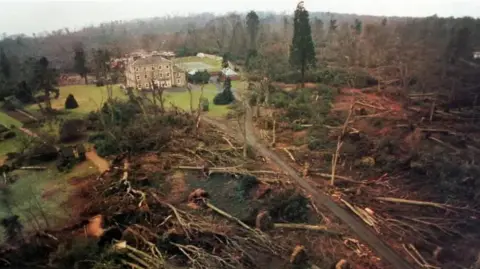'My car was hit by pebbles that had blown 300ft'
 Jo Burn/BBC
Jo Burn/BBCA man from Kent has been recollecting the night he hid under his desk for fear that the windows would blow in in storm force winds.
Coastguard officer Pete Legg was on shift on the top of cliffs at Langdon Cliffs, Dover, when the Great Storm hit overnight on 15 to 16 October 1987.
A total of 18 people died that night and winds registered up to 115 mph (185kmph) on the south and east coasts of England.
Mr Legg said his car was damaged by pebbles "which had come 300ft up a cliff".
He said he was reading his anemograph, which measures wind speed, that night and knew something looked wrong.
A ship had slipped anchor off Dungeness and he had called out the rescue helicopter from Manston after the ship lost power.
The helicopter never arrived.
Mr Legg said: "I was told they can't get their engines started and that was the point when I thought things are getting very serious here.
"I noticed that the windows in the operations room were bulging inwards and they were starting to crack.”
Mr Legg continued: “I told everyone that I didn’t think it was a good idea to be here and suggested that everyone find a desk to hide under.
“Then we had a call from the Folkestone pilots who said that they had a ship due in but they couldn’t speak to it and were unable to locate it on the radar. I asked why they couldn't see it and they said that they were underneath the table.”
He said after the end of his shift he went outside wearing a tin hat.
"I got down to my year-old car to find it was pebble dashed with the windscreen smashed in," he said.
"I really understood then what this was all about.”
 PA/NATIONAL TRUST
PA/NATIONAL TRUSTIt was the worst storm to hit Britain for almost 300 years and saw 18 people killed and 15 million trees felled overnight.
Sevenoaks lost all but one of its iconic trees.
A ferry, The Hengist, beached at Folkestone.
More than 20,000 trees were destroyed at Wakehurst, near Ardingly, in West Sussex.
The estate, owned by the Royal Botanic Gardens at Kew, had mature gardens, with woodlands dominated by dense tree and shrub planting - but within hours, all that had changed.
Box Hill woodland near Dorking, Surrey, lost 2,000 trees - mostly beech, whose shallow roots made them vulnerable.
Some of the devastated areas were cleared and replanted while others were left to regenerate naturally.
Follow BBC Kent on Facebook, on X, and on Instagram. Send your story ideas to [email protected] or WhatsApp us on 08081 002250.
